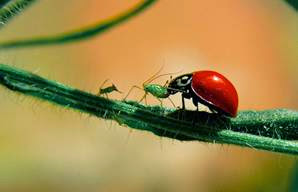Are aphids and other pests wrecking your garden? Partner up with ladybugs to stop the carnage.
By: Melissa Breyer
By: Melissa Breyer
Fri, Jun 13, 2014
Lucky are those whose backyards boast an abundance of ladybugs; not only are they just ridiculously cute, but they are of tremendous benefit to the garden. In addition to their Beatrix Potter-like charm, ladybugs have a voracious appetite for plant-eating pests like aphids, mealy bugs, leafhoppers, mites, scales and other unsavory characters of the insect world. (OK, we don't mean to judge bugs here, but few gardeners like insects that destroy their plants.) Ladybugs are simply one of the best organic ways to manage pests.
While you can buy ladybugs by the pint if you are naturally deficient in them, it may be better not to introduce wild-caught mail-order insects into your ecosystem; they can come with parasites and diseases, or they might not stick around very long. If you do want to purchase them, look for farm-raised ladybugs. (Yes, there are ladybug farms. What a world we live in.)
Fortunately, whether you have no ladybugs, want more ladybugs, or want new ladybugs to stick around for awhile, there are ways to make your garden more attractive to them. Here’s what to do:
Feed them
First up, food; because just like us, the way to a ladybug’s heart is through its stomach. These plants produce pollen whose flavor the ladybugs favor:
Angelica
Calendula
Caraway
Chives
Cilantro
Coreopsis
Cosmos
Dandelions
Dill
Fennel
Feverfew
Marigold
Scented geraniums
Statice
Sweet alyssum
Tansy
Wild carrot
Yarrow
Keep other bugs around
And of course, you need to provide the main dish as well: insects. As hard as it may be, it’s important to tolerate garden pests so that there are enough of them to keep the ladybugs fed. It’s a delicate balance, but it makes sense. You can plant decoy plants that pests love, and that may distract aphids and their ilk from eating the plants that you’re trying to protect; which at the same time, ensures that there are enough aphids for the ladybugs. Plants that aphids love include:
Early cabbage
Marigold
Nasturtium
Radish
Water them
Just like any other creature, ladybugs need water, and shallow bowls of water can provide hydration. (But stagnant bowls of water can also attract mosquitoes, so refresh them frequently.)
Give them shelter
While cute, commercial ladybug houses seem to mostly remain vacant, low-growing ground covers can provide a home to protect these beneficial beetles from ladybug-eating birds and toads. Low, rambling plants like oregano or thyme work well, as will mulch or leaves.
Ditch the pesticides
We know that you know this, but we’ll say it anyway: Pesticides and insecticides are not selective; they will kill your beneficial insects as expertly as they will kill your harmful ones. Don't poison the ladybugs!




